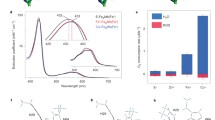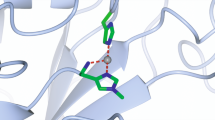Abstract
Co(II) substitution into the copper amine oxidases (CAOs) has been an effective tool for evaluating the mechanism of oxygen reduction in these enzymes. However, formation of hydrogen peroxide during turnover raises questions about the relevant oxidation state of the cobalt in these enzymes and, therefore, the interpretation of the activity of the metal-substituted enzyme with respect to its mechanism of action. In this study, Co(II) was incorporated into the CAO from Hansenula polymorpha (HPAO). The effect of hydrogen peroxide on the catalytic activity of cobalt-substituted HPAO was evaluated. Hydrogen peroxide, either generated during turnover or added exogenously, caused a decrease in the activity of the enzyme but did not oxidize Co(II) to Co(III). These results are in strong contrast with results from the CAO from Arthrobacter globiformis (AGAO), where hydrogen peroxide causes an increase in the activity of the enzyme as the Co(II) is oxidized to Co(III). The results of this study with HPAO support previous reports that have shown that this enzyme acts by transferring an electron directly from the reduced TPQ cofactor to dioxygen rather than passing the electron through the bound metal ion. Furthermore, these results provide additional evidence to support the idea that different CAOs use different mechanisms for catalysis.






Similar content being viewed by others
Abbreviations
- AGAO:
-
Arthrobacter globiformis amine oxidase
- CAO:
-
Copper amine oxidase
- CoHPAO:
-
Cobalt-substituted HPAO
- CuDepHPAO:
-
Copper-depleted HPAO
- EPR:
-
Electron paramagnetic resonance
- HPAO:
-
Hansenula polymorpha amine oxidase
- ICP-AES:
-
Inductively coupled plasma-atomic emission spectroscopy
- MOPS:
-
3-(N-Morpholino)-propanesulfonic acid
- PHZ:
-
Phenylhydrazine
- PSAO:
-
Pea seedling amine oxidase
- TPQ:
-
2,4,5-Trihydroxyphenylalanyl quinone
References
McIntire WS, Hartmann C (1993) Copper-containing amine oxidases. In: Davidson VL (ed) Principles and applications of quinoproteins. Marcel Dekker Inc, New York, pp 97–171
Klinman JP (2003) The multi-functional topa-quinone copper amine oxidases. Biochim Biophys Acta 1647:131–137
Mure M, Mills SA, Klinman JP (2002) Catalytic mechanism of the topa quinone containing copper amine oxidases. Biochemistry 41:9269–9278
Mure M (2004) Tyrosine-derived quinone cofactors. Acc Chem Res 37:131–139. https://doi.org/10.1021/ar9703342
Mills SA, Klinman JP (2000) Evidence against reduction of Cu2+ to Cu+ during dioxygen activation in a copper amine oxidase from yeast. J Am Chem Soc 122:9897–9904
Su Q, Klinman JP (1998) Probing the mechanism of proton coupled electron transfer to dioxygen: the oxidative half-reaction of bovine serum amine oxidase. Biochemistry 37:12513–12525. https://doi.org/10.1021/bi981103l
Dooley DM, McGuirl MA, Brown DE et al (1991) A Cu(I)-semiquinone state in substrate-reduced amine oxidases. Nature 349:262–264. https://doi.org/10.1038/349262a0
Mukherjee A, Smirnov VV, Lanci MP et al (2008) Inner-sphere mechanism for molecular oxygen reduction catalyzed by copper amine oxidases. J Am Chem Soc 130:9459–9473. https://doi.org/10.1021/ja801378f
Mills S, Brown D, Dang K et al (2012) Cobalt substitution supports an inner-sphere electron transfer mechanism for oxygen reduction in pea seedling amine oxidase. J Biol Inorg Chem 17:507–515. https://doi.org/10.1007/s00775-011-0872-x
Turowski PN, McGuirl MA, Dooley DM (1993) Intramolecular electron transfer rate between active-site copper and topa quinone in pea seedling amine oxidase. J Biol Chem 268:17680–17682
Dooley DM, Brown DE (1996) Intramolecular electron transfer in the oxidation of amines by methylamine oxidase from Arthrobacter P1. J Biol Inorg Chem 1:205–209. https://doi.org/10.1007/s007750050044
Shepard EM, Okonski KM, Dooley DM (2008) Kinetics and spectroscopic evidence that the Cu(I)-semiquinone intermediate reduces molecular oxygen in the oxidative half-reaction of Arthrobacter globiformis amine oxidase. Biochemistry 47:13907–13920. https://doi.org/10.1021/bi8011516
Shepard EM, Dooley DM (2006) Intramolecular electron transfer rate between active-site copper and TPQ in Arthrobacter globiformis amine oxidase. J Biol Inorg Chem 11:1039–1048. https://doi.org/10.1007/s00775-006-0153-2
Liu Y, Mukherjee A, Nahumi N et al (2013) Experimental and computational evidence of metal-O2 activation and rate-limiting proton-coupled electron transfer in a copper amine oxidase. J Phys Chem B 117:218–229. https://doi.org/10.1021/jp3121484
Mills SA, Goto Y, Su QJ et al (2002) Mechanistic comparison of the cobalt-substituted and wild-type copper amine oxidase from Hansenula polymorpha. Biochemistry 41:10577–10584. https://doi.org/10.1021/bi0200864
Acknowledgements
SAM acknowledges the other Xavier students who work in the lab. SAM and KEG acknowledge the Xavier University Office of Undergraduate Research for support.
Author information
Authors and Affiliations
Corresponding author
Additional information
This work is dedicated to Prof. Justine P. Roth, who was a brilliant scientist and great sounding board for ideas.
Rights and permissions
About this article
Cite this article
Mills, S.A., Gazica, K.E. & Tierney, D.L. Co(II) is not oxidized during turnover in the copper amine oxidase from Hansenula polymorpha. J Biol Inorg Chem 24, 31–37 (2019). https://doi.org/10.1007/s00775-018-1624-y
Received:
Accepted:
Published:
Issue Date:
DOI: https://doi.org/10.1007/s00775-018-1624-y




